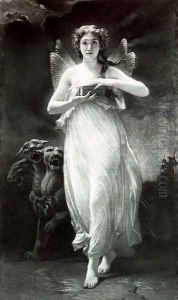Paul Alfred de Curzon Paintings
Paul Alfred de Curzon was a 19th-century French painter known for his historical and genre scenes. Born on February 20, 1820, in Périgueux, Dordogne, France, Curzon was part of a period in European art that saw significant transitions, with Romanticism giving way to Realism and the early stirrings of Impressionism.
Educated in the arts, Curzon honed his skills and pursued his passion for painting. However, unlike some of his contemporaries, he did not achieve the same level of fame as artists like Eugène Delacroix or Gustave Courbet. His style was characterized by a detailed and academic approach to painting, with a focus on historical accuracy and traditional techniques. This approach was more aligned with the French Academy's standards and the Salon, which was the official art exhibition of the Académie des Beaux-Arts in Paris.
Throughout his career, Curzon exhibited his works at the Salon, where he received recognition for his talent. His subject matter often included scenes from French history, reflecting a nationalistic sentiment that was popular at the time. He also painted religious themes and portraits, which were well-received by patrons and the art establishment.
Despite his adherence to traditional styles, Curzon's work was part of a broader French art narrative that grappled with themes of history, national identity, and the human experience. His paintings are noted for their clarity, composition, and attention to detail, reflecting a meticulous nature.
Paul Alfred de Curzon passed away on January 19, 1895, in Paris. While he may not have been a trailblazer in the same way as the Impressionists or other avant-garde movements of his time, his contributions to French art history provide insight into the cultural and artistic milieu of the 19th century. His works remain a testament to the academic art traditions that dominated France before the full advent of modernism.


